In Their Own Words: Daniel Simberloff
In Their Own Words: Daniel Simberloff https://academic.oup.com/bioscience/article/72/10/945/6612801#no-access-message
by ldutton
In Their Own Words: Daniel Simberloff https://academic.oup.com/bioscience/article/72/10/945/6612801#no-access-message
by artsciweb
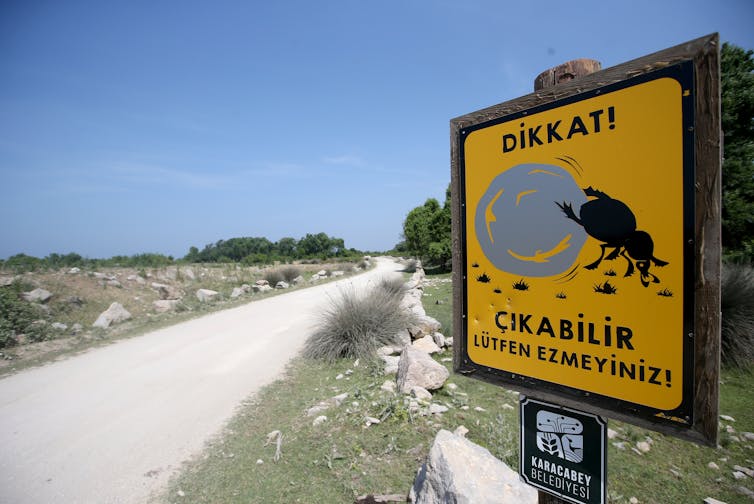
Kimberly S. Sheldon, University of Tennessee
If the TV series “Dirty Jobs” covered animals as well as humans, it would probably start with dung beetles. These hardworking critters are among the insect world’s most important recyclers. They eat and bury manure from many other species, recycling nutrients and improving soil as they go.
Dung beetles are found on every continent except Antarctica, in forests, grasslands, prairies and deserts. And now, like many other species, they are coping with the effects of climate change.
I am an ecologist who has spent nearly 20 years studying dung beetles. My research spans tropical and temperate ecosystems, and focuses on how these beneficial animals respond to temperature changes.
Insects don’t use internally generated heat to maintain their body temperature. Adults can take actions such as moving to warmer or colder areas. However, earlier life stages such as larvae are often less mobile, so they can be strongly affected by changing temperatures.
But dung beetles appear to have a defense: I have found that adult dung beetles modify their nesting behaviors in response to temperature changes by burying their brood balls deeper in the soil, which protects their developing offspring.
It’s easy to joke about these busy insects, but by collecting and burying manure, dung beetles provide many ecological benefits. They recycle nutrients, aerate soil, lessen greenhouse gas emissions from cattle farming and reduce pest and parasite populations that harm livestock.
Dung beetles are also important secondary seed dispersers. Dung from other animals, such as bears and monkeys, contains seeds that the beetles bury underground. This protects the seeds from being eaten, makes them more likely to germinate and improves plant growth.
There are roughly 6,000 species of dung beetles around the world. Most feed exclusively on dung, though some will feed on dead animals, decaying fruit and fungi.
Some species use stars and even the Milky Way to navigate along straight paths. One species, the bull-headed dung beetle (Onthophagus taurus), is the world’s strongest insect, able to pull over 1,000 times its own body weight.
That strength comes in handy for dung beetles’ best-known behavior: gathering manure.
Most popular images of dung beetles show them collecting manure and rolling it into balls to spirit away. In fact, some species are rollers and others are tunnelers that dig into the ground under a dung pat, bring dung down into the tunnel and pack it into a clump or sphere, called a brood ball. The female then lays an egg in each brood ball and backfills the tunnel with soil. Rollers do the same once they get their dung ball safely away from the competition.
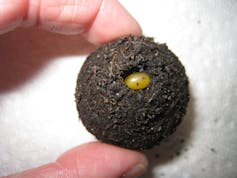
When the egg hatches, the larva feeds on dung from the brood ball, pupates and emerges as an adult. It thus goes through complete metamorphosis – from egg to larva to pupa to adult – inside the brood ball.
Dung beetle parents don’t provide care for their offspring, but their nesting behaviors affect the next generation. If a female places a brood ball deeper underground, the larva in the brood ball experiences cooler, less variable temperatures than it would nearer the surface.
This matters because temperatures during development can affect offspring survival and other traits, such as adult body size. If temperatures are too hot, offspring perish. Below that point, warmer, more variable temperatures lead to smaller-bodied beetles, which can affect the next generation’s reproductive success.
Smaller males can’t compete as well as larger males, and smaller females have lower reproductive output than larger females. In addition, smaller-bodied beetles remove less dung, so they provide fewer benefits to humans and ecosystems, such as nutrient cycling.
Climate change is making temperatures more variable in many parts of the world. This means that insects and other species have to handle not just warmer temperatures, but greater changes in temperature day to day.
To examine how adult dung beetles responded to the types of temperature shifts associated with climate change, I designed cone-shaped mini-greenhouses that would fit over 7-gallon buckets buried in the ground to their brims. Will Kirkpatrick, an undergraduate student in my lab, led the field trials.
We randomly placed a fertilized female rainbow scarab, Phanaeus vindex, in each greenhouse bucket and in the same number of uncovered buckets to serve as controls. Using temperature data loggers placed at four depths in the buckets, we verified that soil temperatures in “greenhouse” buckets were warmer and more variable than soil temperatures in uncovered buckets.
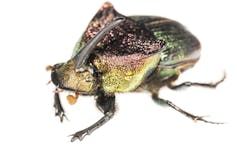
We gave the beetles fresh cow dung every other day for 10 days and allowed them to make brood balls. Then we carefully dug through the buckets and recorded the number, depth and size of brood balls in each bucket.
We found that beetle mothers in greenhouse environments created more brood balls overall, that these brood balls were smaller, and that these females buried their brood balls deeper in the soil than beetle mothers in control buckets. Brood balls in the greenhouses still ended up in areas that were slightly warmer than those in the control buckets – but not nearly as warm as if the beetle mothers had not altered their nesting behaviors.

However, by digging deeper, the adults fully compensated for temperature variation. There was no difference in the temperature variation experienced by brood balls in greenhouse buckets and control buckets. This reflects the fact that soil temperatures become increasingly stable with depth as the soil becomes more and more insulated from the changing air temperatures above it.
Our findings also hint at a possible trade-off between burial depth and brood ball size. Beetle mothers that dug deeper protected their offspring from temperature changes but provided less dung in their brood balls. This meant less nutrition for developing offspring.
Climate change could still affect adult dung beetles in ways we did not test, with consequences for the next generation. In future work, we plan to place brood balls of Phanaeus vindex and other species of dung beetles back into the greenhouse and control buckets at the depths at which they were buried so that we can see how the beetle offspring develop and survive.
So far, though, my colleagues and are encouraged to find that these industrious beetles can alter their behavior in ways that may help them survive in a changing world.
Kimberly S. Sheldon, Associate Professor of Ecology and Evolutionary Biology, University of Tennessee
This article is republished from The Conversation under a Creative Commons license. Read the original article.
by artsciweb
Assistant Professor Laura Russo is part of a research team that published findings from an experiment to provide evidenced-based recommendations for pollinator-friendly native perennials in eastern Tennessee.
Download the UT Institute of Agriculture Extension Publication: Planting for Pollinators in East Tennessee, authored by Virginia Sykes, Department of Plant Sciences, Karl McKim and Laura Russo, Department of Ecology and Evolutionary Biology, and Amani Khalil, Oak Ridge Institute for Science and Education.
by artsciweb
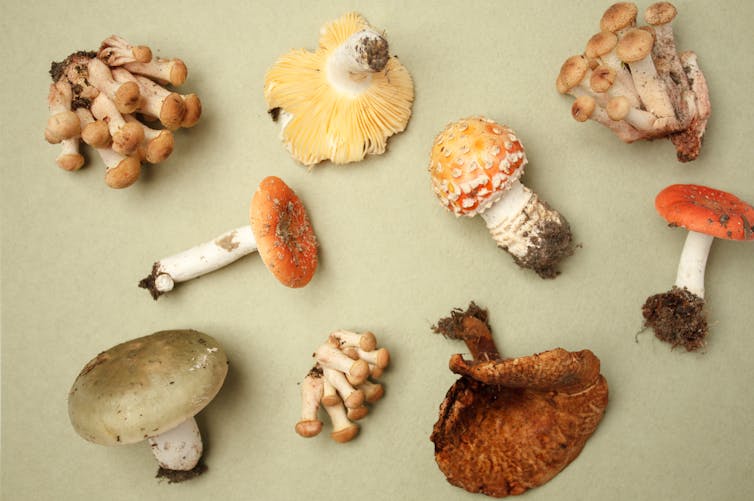
Karen Hughes, University of Tennessee

Curious Kids is a series for children of all ages. If you have a question you’d like an expert to answer, send it to curiouskidsus@theconversation.com.
Why are some mushrooms poisonous and some are not? – Alice T., age 11
You may have noticed that mushrooms pop up in your yard or in parks right after a rain but don’t last for long.
A mushroom is the above-ground part of a fungus. Most of the time, fungi live as threadlike structures called hyphae underground or in materials like wood. For fungi to reproduce, a mushroom must form above ground.
Some mushrooms are poisonous for the same reason some plants are poisonous – to protect themselves from being eaten so they can reproduce. Other mushrooms use the opposite strategy. They need animals to eat them in order to spread spores through poop. Still other mushrooms have completely different game plans.
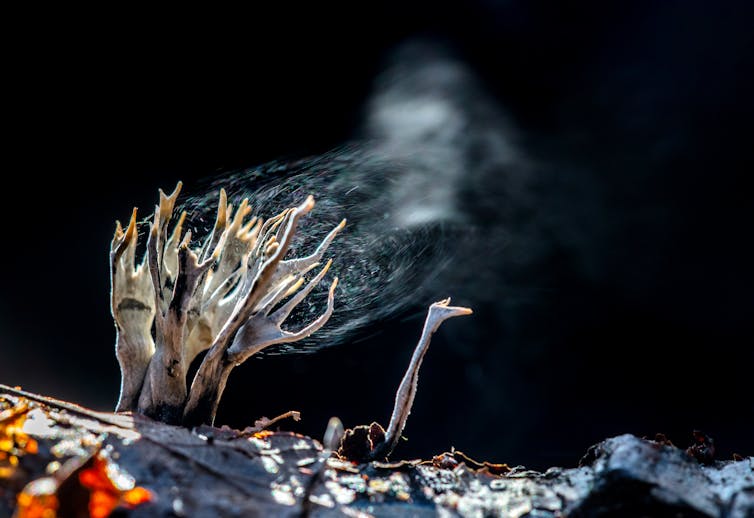
Mushrooms develop when the temperature is right and there is enough water. They usually consist of a cap and a stalk. On the underside of the cap, mushrooms produce spores that, like the seeds of plants, produce new fungi.
If you peek under a variety of mushroom caps, you will notice they are not all the same.
Some mushrooms have gills that look like a pleated sheet of paper. Some have pores that look like sponges. And some have toothlike structures. All of these surfaces produce spores. To create a new generation of fungi, spores need to get to new areas – and there are many fascinating ways mushrooms accomplish this.
For some mushrooms, spores simply fall from their caps and are carried to new homes by air currents.
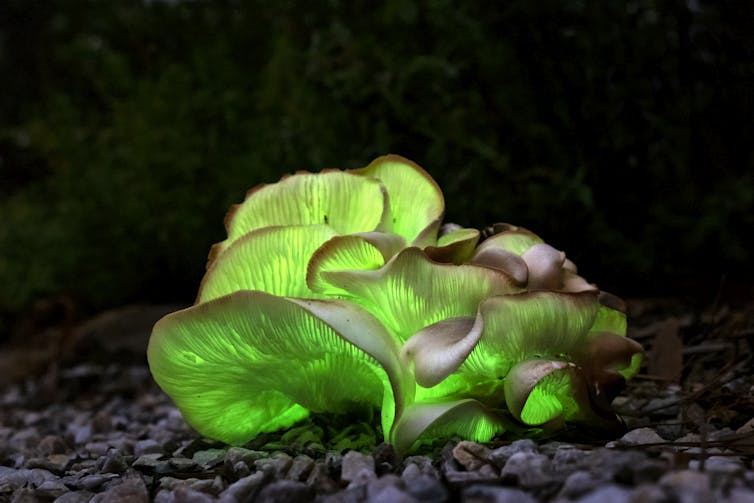
Other mushrooms attract insects by glowing at night. The glow from fungi in the woods at night can be very strong and is sometimes called foxfire. Insects, which are attracted to the light, inadvertently pick up spores as they investigate the glow and carry them elsewhere when they move on.
Some mushrooms never form an above-ground structure. Instead the mushroom stays underground and is eaten by squirrels and mice, which spread the spores by taking pieces back to their nests and by pooping. Such mushrooms are called truffles, and sometimes people will pay a lot of money for them.
Since mushrooms don’t last long, it’s important they spread their spores quickly. This is where poisons and toxins can come in.
Mushrooms are pretty tasty to snails, some insects, beetles, chipmunks, squirrels, deer and people. If an animal eats a mushroom, usually its spores are lost – unless they’re the type encased in a protective covering meant to be carried to a new neighborhood in poop.
Scientists have figured out that insects and snails avoid eating mushrooms that contain poison. Some mushroom poisons may make the eater only sick enough to avoid that species in the future, but some can be fatal.

There are many different mushroom poisons. One kind belongs to a group of very beautiful mushrooms, the amanitas, also called “destroying angels” because they are both pretty and deadly. Amanitas are often mistaken for mushrooms that can be eaten, and they cause several deaths worldwide each year.
People use some mushroom poisons in medicine. The poison of the ergot fungus, for example, was developed into a drug used to prevent migraine headaches.
Approximately 1%-2% of mushrooms are poisonous to humans. The common term for such a mushroom is a “toadstool,” but there is no easy way to distinguish a poisonous mushroom from one that is edible. So it’s not a good idea to eat mushrooms you find, because it’s hard to be sure whether they’re poisonous or not.
Many mushrooms are healthy and delicious. Just make sure you get them from a store or from someone who is a mushroom expert.
Hello, curious kids! Do you have a question you’d like an expert to answer? Ask an adult to send your question to CuriousKidsUS@theconversation.com. Please tell us your name, age and the city where you live.
And since curiosity has no age limit – adults, let us know what you’re wondering, too. We won’t be able to answer every question, but we will do our best.
Karen Hughes, Professor of Mycology, University of Tennessee
This article is republished from The Conversation under a Creative Commons license. Read the original article.
by artsciweb
Protected areas are critical to mitigating extinction of species; however, they may also be in conflict with efforts to feed the growing human population.
Paul Armsworth, professor of ecology and researcher with the National Institute for Mathematical and Biological Synthesis (NIMBioS) is the co-author of a new study showing croplands are prevalent in protected areas, which challenges their efficacy meeting conversation goals. Varsha Vijay, a researcher at the University of Maryland’s National Socio-Environmental Synthesis Center (SESYNC) is the lead author.
The study, published in the Proceedings of the National Academy of Sciences, shows that 6% of all global terrestrial protected areas are already made up of cropland, a heavily modified habitat that is often not suitable for supporting wildlife. Worse, 22% of this cropland occurs in areas supposedly enjoying the strictest levels of protection, the keystone of global biodiversity protection efforts.
In order to comprehensively examine global cropland impacts in protected areas for the first time, the authors synthesized a number of remotely sensed cropland estimates and diverse socio-environmental datasets.
Read more about the study at sesync.org.
by artsciweb
ISLAND CONSERVATION STUDY- GUAM KINGFISHER AND THE BROWN TREE SNAKE
1-2 Student Research Assistants will be hired ($15/hour) to work with a multidisciplinary team evaluating the likelihood of Guam kingfisher Todiramphus cinnamominus reintroduction success on the western Pacific island of Guam.
STUDY DESCRIPTION
Since 1988, the critically endangered Guam kingfisher has survived solely in captivity. Now only ca. 140 birds remain in 23 US facilities. Because captive propagation selects for birds that do well in captivity, not necessarily in the wild, re-establishment in the wild is ideal. However, the invasive predator credited with driving the bird close to extinction, the brown tree snake Boiga irregularis, is still present on Guam. To aid development of successful reintroduction strategies, our team will evaluate previous reintroduction successes and failures alongside activities and outcomes associated with needed habitat restoration on Guam, e.g., kingfisher and snake population modeling, snake monitoring and control methods, and impacts of other invasive species.
DUTIES
Student Research Assistants will identify and summarize then thoughtfully interpret and report about outcomes of various captive propagation and invasive species control programs as they relate to reintroduction of the kingfisher and control of the brown tree snake. This position requires office work (10-20 hours/week) at the University of Tennessee, Knoxville, in the Department of Ecology & Evolutionary Biology. With timely and detail-oriented progress, employment will continue through 31 December 2020, and extension beyond December 2020 is possible.
STUDENT BENEFIT
Student Research Assistants will gain significant experience through participation in an ongoing, pressing conservation action involving a critically endangered species and a notorious invasive predator in an island ecosystem.
DESIRED QUALIFICATIONS
Working familiarity with scientific literature databases; skill in literature-based research and organization; ability to meet deadlines and to write clearly and scientifically (i.e., to produce summaries, progress reports, and draft text for refereed publications); competency in Microsoft Word, Excel, and PowerPoint; willingness to work pleasantly and communicate regularly as part of a team; enthusiasm for digesting large amounts of information to solve problems in conservation biology
TO APPLY
Submit as a single document: cover letter, 500- to 1000-word essay explaining how your qualifications match those of the position, resume or CV, and two references (name, title, affiliation, contact information, relationship, and length of relationship). Please also submit a copy of your transcripts (official or unofficial transcripts are acceptable). Email your application to Dr. Christy Leppanen, Department of Ecology & Evolutionary Biology, University of Tennessee (cleppane [at] utk.edu) using the subject line: KINGFISHER POSITION.
CLOSING DATE
Applications will be accepted until positions are filled.
by artsciweb
A new study published in Ecology Letters suggests there is more to plant competition than ecologists initially thought.
Plants interact with many biotic entities – from other plants and microorganisms to animals – but little is known about the relative influence each of these interactions has on determining plant growth and survival. Most plants compete with each other for resources, such as space and light. Plants also interact with microbial mutualists, which can be beneficial for the plants because these microorganisms acquire nutrients the plant needs to grow and thrive. The interplay of all these interactions determines the success and growth of an individual plant.
“The relative importance of competition versus plant soil feedback on plant performance is poorly understood,” says Stephanie Kivlin, co-author and assistant professor in the Department of Ecology and Evolutionary Biology.
Kivlin and her colleagues quantified the relative importance of plant-plant and plant-microbial interactions on plant growth across 150 difference plant species. They discovered that competitive plant-plant interactions were the main driver of plant growth, but negative plant-microbial interactions were also prevalent.
“What we discovered suggests microbes limit plant growth of the strongest competitor in a variety of natural ecosystems,” Kivlin says.
Microbes and fungi can have a significant impact on plant diversity. Without them, plants that compete best for light, water, and nutrients would dominate environments such as grasslands and forests. This study suggests microorganisms play a key role in maintaining biodiversity of plant species in natural environments.
Since this is the first work to document the relative importance of plant-plant and plant-microbial interactions, it will most likely shape the theory about when and where each of these interactions structures plant community diversity and composition.
“Our department is a hub of biodiversity and conservation research,” Kivlin says. “As we move forward as a center for biodiversity research in one of the most biodiverse areas on the planet, this work will be key in reminding us to consider the invisible microbial actors that silently structure many of the plant communities in this region and across the globe.”
The authors would like to acknowledge MPG Ranch for generously supporting the plant-soil feedback workshop that generated the ideas for this publication.